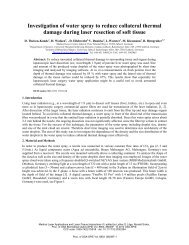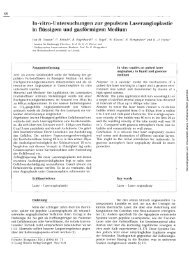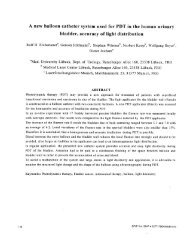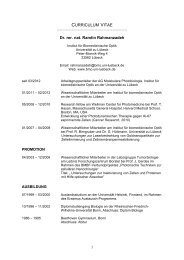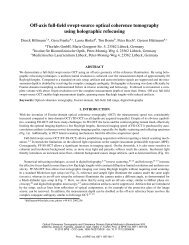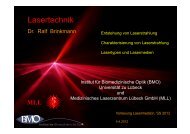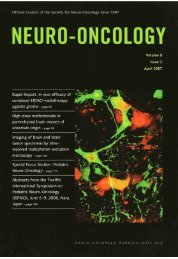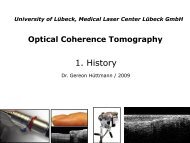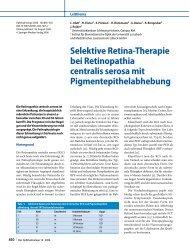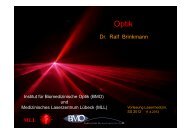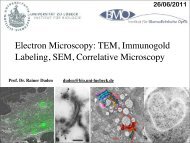1036 Applied Physics B – Lasers and Opticswhere p 0 is the initial thermoelastic pressure generated underconditions <strong>of</strong> stress confinement and the integration encompassesthe entire volume that is heated by the <strong>laser</strong> pulse. Fora temperature rise in the center <strong>of</strong> the focal volume <strong>of</strong> 180 ◦ Csuch as in Fig. 19 that leads to a maximum pressure p 0 <strong>of</strong>221 MPa, E TE amounts to 7.8 × 10 −14 J. For comparison, thetotal heat content <strong>of</strong> the plasma isE tot = ϱ 0 C p∫∆T dV , (23)giving E tot = 1.66 × 10 −11 J under the same conditions. Theenergetic conversion efficiency from heat into the thermoelasticwave is therefore E TE /E tot = 0.46%, and the conversionefficiency from thermoelastic energy into bubble energy is6.8%. This result <strong>of</strong> a low conversion efficiency from absorbed<strong>laser</strong> energy into mechanical energy for <strong>femtosecond</strong>pulses is in agreement with experimental results [80, 128]. Bycontrast, for nanosecond optical breakdown with NA = 0.9the conversion efficiency was experimentally found to be12.7% for λ = 1064 nm and 3.3% for λ = 532 nm at the breakdownthreshold, and it reached values <strong>of</strong> 53% and 33.5%,respectively, for energies 10-fold above threshold [3].FIGURE 18 Two-dimensional plots <strong>of</strong> the thermoelastic stress evolution(left) and <strong>of</strong> the region in which the kinetic spinodal limit is exceeded (right).This region demarcates the size <strong>of</strong> the bubble nucleus that is then expandedby the thermoelastic tensile stress wave. The calculations were performed fora peak temperature <strong>of</strong> 200 ◦ CExperimental data on cavitation bubble dynamics. Timeresolvedinvestigations <strong>of</strong> the effects <strong>of</strong> transient <strong>femtosecond</strong><strong>laser</strong>-inducedbubbles on cells are not yet available. However,Dayton et al. investigated the oscillations <strong>of</strong> 1.5-µm-radiusbubbles that were phagocytosed by leukocytes and stimulatedby a rarefaction-first one-cycle acoustic pulse with 440 ns duration[188]. By means <strong>of</strong> streak photography and high-speedphotography with 100 Mill. f/s they observed that phagocytosedbubbles expanded about 20%–45% less than freemicrobubbles in response to a single acoustic pulse <strong>of</strong> thesame intensity. The difference is due to the viscosity <strong>of</strong> thecytoplasm and the elastic modulus <strong>of</strong> the cytoskeleton. Bubblessubjected to a tensile-stress amplitude <strong>of</strong> 0.9MPawouldexpand to a radius <strong>of</strong> 6 µm without rupturing the cell membrane.Larger oscillations would cause immediate cell lysis.The viability <strong>of</strong> the non-lysed cells after insonation was nottested, but it is evident that the bubble oscillations strain thecell membrane and deform or even rupture the cytoskeleton.In the case <strong>of</strong> <strong>femtosecond</strong> optical breakdown, the radius <strong>of</strong>the bubble nucleus is much smaller (≈ 90 nm compared to1.5 µm), and the tensile-stress transient acting on the bubblesis much shorter than in the case investigated by Dayton(≈ 100 ps compared to 220 ns). Therefore, the resulting bubblescause little structural damage within a cell and do notaffect cell viability.Lin et al. investigated the thresholds for cell death producedby cavitation induced around absorbing microparticlesirradiated by nanosecond <strong>laser</strong> pulses [189, 190]. Theyobserved that an energy <strong>of</strong> 3nJ absorbed by a single particle<strong>of</strong> 1-µm diameter produced sufficiently strong cavitationto kill a trabecular meshwork cell after irradiation witha single <strong>laser</strong> pulse. Pulses with 1-nJ absorbed energy producedlethality after several exposures [189]. Viability waslost even when no morphological damage was apparent immediatelyafter the collapse <strong>of</strong> the transient bubble with lessthan 1-µs lifetime (according to the Rayleigh equation [96,191], 1-µs lifetime corresponds to R max = 5.5 µm). Nuclear
VOGEL et al. <strong>Mechanisms</strong> <strong>of</strong> <strong>femtosecond</strong> <strong>laser</strong> <strong>nanosurgery</strong> <strong>of</strong> cells and tissues 1037FIGURE 19 Radius–time curve <strong>of</strong> the cavitation bubble produced by a single <strong>femtosecond</strong> <strong>laser</strong> pulse focused at NA = 1.3 that leads to a peak temperature<strong>of</strong> T max = 200 ◦ C at the focus center. The radius <strong>of</strong> the bubble nucleus is R 0 = 91.1 nm. The temperature at the wall <strong>of</strong> the nucleus is T wall = 145 ◦ C, and themean temperature averaged over all volume elements within the bubble nucleus is T mean = 168 ◦ C. The R(t) curve in (a) was calculated under the assumptionthat the vapor pressure within the bubble is given by the mean temperature within the nucleus and decays due to heat diffusion (case 1, see text). The curve in(b) was calculated assuming that the vapor pressure drops adiabatically during bubble expansion (case 2)FIGURE 20 Maximum bubble radii for cases 1 and 2 as a function <strong>of</strong> themaximum temperature achieved in the center <strong>of</strong> the focal volume, togetherwith the radius <strong>of</strong> the nucleus, R 0staining <strong>of</strong> non-viable cells by ethidium bromide confirmedthat cell death was associated with membrane damage. Accordingto Neumann and Brinkmann [192], a bubble radius <strong>of</strong>3 µm within a cell <strong>of</strong> 7.5-µm radius is sufficient to cause anenlargement <strong>of</strong> the membrane by 4% that will result in membranerupture [193]. The results <strong>of</strong> our calculations in Fig. 20demonstrate that the radius <strong>of</strong> fs-<strong>laser</strong>-produced transient bubblesremains well below this damage threshold. This applieseven for <strong>laser</strong> pulse energies <strong>of</strong> a few nanojoules because forϱ cr = 10 21 cm −3 and 1-µm plasma length about 99% <strong>of</strong> theincident energy is transmitted through the focal region [81].The heated volume is much smaller than the volume <strong>of</strong> themicroparticles investigated by Lin et al. [189], and the depositedheat energy corresponding to a peak temperature <strong>of</strong>T max = 200 ◦ C or 300 ◦ C is only 16.6 or 25.8pJ, respectively,much less than in Lin’s case.Bubbles around gold nanoparticles are <strong>of</strong> interest in thecontext <strong>of</strong> nanoparticle cell surgery (Sect. 1.1). When particleswith 4.5-nm radius were irradiated by 400-nm, 50-fspulses, bubbles <strong>of</strong> up to 20-nm radius were observed by means<strong>of</strong> X-ray scattering techniques [194]. The small size <strong>of</strong> thesebubbles, which is one order <strong>of</strong> magnitude less than for thoseproduced by focused <strong>femtosecond</strong> <strong>laser</strong> pulses, is consistentwith the fact that the collective action <strong>of</strong> a large number<strong>of</strong> nanoparticles is required to produce the desired surgicaleffect.Membrane damage can also be induced by bubble oscillationsthat occur largely outside the cell [195], such as in<strong>laser</strong> optoporation [50]. Rupture (or at least poration) <strong>of</strong> thecell membrane requires strains larger than 2%–3% [193, 196].Again, no time-resolved investigations <strong>of</strong> the <strong>laser</strong>-based procedureare yet available, but cell poration and lysis induced bythe dynamics <strong>of</strong> pressure-wave-excited bubbles have alreadybeen studied [197]. These effects are <strong>of</strong> interest in the context<strong>of</strong> transient membrane permeabilization <strong>of</strong> cells for thetransfer <strong>of</strong> genes or other substances.So far, we have only discussed the transient bubbles producedby single <strong>laser</strong> pulses. These bubbles can only be detectedby very fast measurement schemes. However, duringhigh-repetition-rate pulse series accumulative thermal effectsand chemical dissociation <strong>of</strong> biomolecules come into play(Sects. 4 and 5.2) that can produce long-lasting bubbles thatare easily observable under the microscope [86, 88, 89]. Dissociation<strong>of</strong> biomolecules may provide inhomogeneous nucleithat lower the bubble-formation threshold below the superheatlimit defined by the kinetic spinodal. Even thoughthermoelastic forces may still support the bubble growth, itis mainly driven by boiling <strong>of</strong> cell water and by chemicalor thermal decomposition <strong>of</strong> biomolecules into small volatilefragments. After the end <strong>of</strong> the fs pulse train, the vapor willrapidly condense but the volatile decomposition products willdisappear only by dissolution into the surrounding liquid andthus form a longer-lasting bubble.Long-lasting ‘residual’ bubbles have also been observedafter pulse series <strong>of</strong> 3.8-kHz repetition rate where, accordingto our results Sect. 5.2, accumulative thermal effects canbe excluded, but they were seen only when fairly large pulseenergies <strong>of</strong> ≥ 180 nJ were applied [198]. The experimentswere performed using a numerical <strong>aper</strong>ture <strong>of</strong> NA = 0.6.Ourtemperature calculations revealed that, at this NA, the energyrequired to produce any specific temperature rise is 22.7 times



